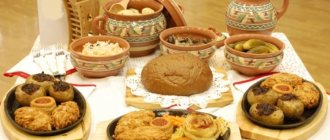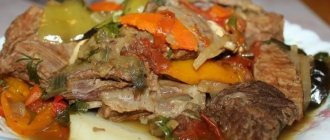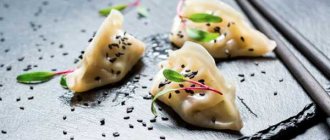Features of national Polish cuisine
The features of national Polish cuisine were formed gradually. But despite the fact that many factors influenced the culture and history of the country, Poland has retained its gastronomic characteristics. Even if they are a little unusual for some, they give Polish cuisine its own flavor and make it special.
The characteristic features of Polish cuisine are:
- Meat makes the dish filling and tasty. The Poles know a lot about preparing this product, and they cook not only from pork, beef or chicken; game can also often be found.
- Adding and consuming dairy products. Poles love dairy products both in pure form and as additives. Soups are often prepared using sour cream, sauces and various salad dressings are made.
- Vegetables - these products are as popular as meat. Salads are made from fresh vegetables, which are seasoned with sour cream, lemon juice, mustard and other dressings.
- Soup is a dish that Poles can use to replace both main course and dessert. Poles eat the first dish for both lunch and dinner. They love soups, the variety of which will amazingly surprise you.
- Conservation has a special place. Sauerkraut, pickled cucumbers, pickled mushrooms and other delicacies very often serve as an addition to many dishes.
- Traditional cuisine does not have a distinct taste. But it clearly preserves the taste of each product. © https://ydoo.info/polskaja-kuhnja.htmlThe combination of sweet, sour and salty makes Polish cuisine original.
If you want to try national dishes prepared according to classic recipes, go to small cafes. In such places, as a rule, the traditions of cooking have been preserved.
Another distinctive feature of Polish cuisine can be safely called sausages. They are prepared in special ways: they are smoked on deciduous trees, and juniper fruits, caraway seeds, nutmeg and other spices are added to the minced meat. Such additives make Polish sausage very tasty and aromatic.
https://youtu.be/6Tr2iQYbzrU
Kremówka
Another popular cake, in Warsaw its name sounds like Napoleonka. Although the dessert came to Poland from French cuisine, there is a version that its name comes from the word “Neapolitan” and is in no way connected with the name of Bonaparte. This is a rectangle-shaped dessert with vanilla cream between two layers of thin dough. The Polish Pope John Paul II was a great connoisseur of this sweetness.
When ordering dessert in a café in Wroclaw, keep in mind that there are both names used to designate two different desserts: kremuvka - a cake with butter cream, and napoleonka layered with vanilla pudding.
Traditional soups
Traditional soups of Polish cuisine, as mentioned earlier, occupy one of the main places in the diet of every resident. Soups are cooked vegetable, meat, hot and cold. For broths, Poles use animals raised in their households. The difference between the Poles is that they try to use the animal completely. They are convinced that anything can be made into something. That’s why among the variety of Polish soups there are dishes made from goose blood and broths made from beef stomachs. Polish soups, like Polish cuisine itself, are very satisfying and rich. Recipes for first courses vary. It all depends on the region in which the dish is prepared.
Traditional Polish soups are always served with a piece of rye bread, which improves the digestion process and helps digest fatty foods.
Among the traditional soups of Polish cuisine, the following first courses should be highlighted:
- Zurek - this soup is prepared with sourdough from rye flour (it is also called “zhura” - this is where the name of the soup itself comes from). In each region, zurek is prepared differently, and each housewife has her own special secret for preparing the soup. Only the starter remains unchanged (which is prepared specifically for the soup for several days). Also, chicken eggs and smoked meats are always added to the soup. The taste of zhurek is somewhat reminiscent of rassolnik, a little sour, but the consistency of the soup is creamier.
- Cucumber soup can also be somewhat reminiscent of pickle soup, only the amount of vegetables in this soup is much larger. Potatoes, carrots, parsley root and other vegetables must be added to the soup. This soup can be eaten both cold and hot.
- Rosul - the broth in this soup is clear. Prepared using homemade chicken and beef. Also, small noodles are added to the first course, and before serving, they are sprinkled with herbs, which are not usually saved. Generously sprinkled with herbs, the soup has a wonderful flavor and the pet broth is very light. Poles often eat this soup on Sunday after going to church.
- Flaki - translated from Polish as "offal" - is a soup made from beef tripe (one of the sections of the animal's stomach). This broth is often eaten after celebrations. Flaki is a rich soup that is eaten hot. A variety of vegetables and a large number of spices are added to it, such as nutmeg, bay leaf, allspice, black pepper, and marjoram. This set of spices is necessary in order to overcome the smell of beef stomach. Despite all the preparatory processes, which can last 5 hours, beef stomach has a specific smell, and spices and herbs help give the dish an appetizing aroma.
- Czernina is one of the most memorable soups in Polish cuisine. The first dish, which includes goose blood. The vegetable broth is boiled, and then blood is added (to prevent it from curdling, vinegar and a little salt are added to it). Often served with dumplings. Those who have tried this soup leave only positive reviews. Despite the name, the soup turns out incredibly tasty.
- Kholodnik - this soup is similar to okroshka, and the composition is almost the same. It is customary to add a lot of fresh fatty sour cream to the classic kholodnik recipe. And this soup owes its beautiful color to beets. It is added at the very end of cooking.
- Kapusniak - in Poland, this soup is cooked with smoked brisket and a lot of cabbage is added. Poles love this vegetable, so they prepare cabbage soup from both fresh cabbage and sauerkraut.
- Krupnik - soup based on barley grits helps with colds (Poles believe this). Therefore, during the cold season, they often prepare this hearty dish for themselves. The broth is made with vegetables, a lot of barley is added, and before serving they can add smoked meat or boiled meat separately.
These are not all the first courses of Polish cuisine. But these ones are definitely worth checking out and trying. Moreover, most of them can be easily prepared at home. Polish recipes only seem complicated.
Polish soups are not always served in a bowl. Very often you can see how the dish is served in a loaf of white or black bread. This presentation definitely gives the dish its own flavor.
Polish snacks
All the most interesting snacks you can find in Warsaw are modern. There are many cafes with casseroles
" Polish zapiekanka is half a baguette (20, 30 or 50 cm) stuffed with meat, vegetables, eggs, mushrooms, seasonings and sauces. The combinations are very different.
The baguette is topped with cheese (Gouda, Edam, Cheddar and Emmental) and baked. The crust of the baguette turns out golden brown and crispy, and the cheese melts. In Poland, “casserole” appeared as street food in 1970. For a while it lost popularity, but in 1990 it appeared on the shelves again.
Kiosks with casseroles
Famous hunting sausages - boars
(kabanos) - prepared from pork with various spices (chili, marjoram and cumin). Wild boars appeared in the middle of the 20th century; they were eaten by hunters at rest stops. To make the sausages juicy and nutritious, the pig was specially fed potatoes.
Modern cabanos are thin smoked sausages made from pork, sometimes turkey and beef. You can buy them in the store and take them with you on the road.
Kabanos in Warsaw stores
Meat and other dishes
Meat and other dishes in traditional Polish cuisine are most often prepared using cabbage, potatoes and various grains.
Polish cuisine attracts with its simplicity. No complicated processes or unknown ingredients. Like soups, main courses are very filling, and the portions are always large. Meat is always served with vegetables, stewed, fresh or pickled. Housewives prepare beef in the form of an escalope, in dough or in a roll. The meat is stuffed with cucumbers, onions and served with mustard and horseradish. If you have never tried these dishes before, you should definitely try them.
Here are some of them:
- Bigos or bigus - the dish is prepared not only with meat, but also with sausage. Bigos has long been the hallmark of Poland. There is no specific recipe; the ingredients are all selected depending on the region and time of year. Bigos is prepared from both game and domestic animals. First, all the products are stewed separately, and at the end of cooking, everything is combined and stewed again. A very tasty dish.
- Potato sorcerers - this dish may remind us of zrazy or potato pancakes. To prepare it, the potatoes are soaked and squeezed well so that they do not lose their shape during the cooking process. Sorcerers cook with both meat and sweet fillings. Depending on this, they are served either with sour cream or jam. Sorcerers not only fry, but also stew, which undoubtedly makes them softer.
- Polendvitsa is a smoked sirloin of beef or pork fillet (more like sausage). Beef meat is dried and eaten without heat treatment.
- Saltison or salceson is a dish made from pork offal. The Poles borrowed this recipe from the Italians. The giblets are boiled and mixed with garlic, pepper and various herbs. They put it in the pig's colon (sometimes in the stomach), boil it again, and then bake it. This dish is served cold, like cold cuts. The Poles borrowed this dish from the Italians, added a little of their favorite ingredients - and the result was a very tasty Polish meat snack.
- Pies are an analogue of our dumplings. Despite the name, the dish is completely similar to dumplings. Pies can have any filling: meat, vegetables, cottage cheese, but Poles especially love pie with porridge. Yes, yes, this is such an unusual combination of products. This dish is served with sour cream.
- Zrazy in Poland is made from minced beef, and these cutlets are stuffed with pickles, onions, cracklings and even mustard.
In almost every recipe you can find marjoram and ground black pepper. Poles also love to add parsley, nutmeg, garlic, hot red pepper, coriander, caraway seeds and bay leaves to their dishes. Polish cuisine loves spicy aromas and rich flavors. The love for spices in Polish cuisine comes from the East.
Fish dishes occupy a special place. Among all the dishes, it is worth highlighting fish in Polish. Poles prefer to cook pike perch or cod. Fish is boiled or steamed in Polish. But what makes this dish extraordinary is the sauce, which is prepared on the basis of eggs and cream.
But nevertheless, Polish fish dishes are not prepared throughout Poland. Most often, fish dishes are prepared in those regions where it is possible to catch fish with your own hands.
No feast is complete without strong drinks. Zubrowka is one of the most popular alcoholic drinks in Poland. Prepared with herbs, it has a light, slightly sweet taste.
Poland can also boast of its desserts. Everyone should try Polish pastries: various pies and rolls, donuts and pies that are baked and fried. Such products are filled with jam, rose jam (a very popular additive in Poland), fruits and dried fruits.
Probably, many can notice the great similarity between Polish and Lithuanian cuisine. The names of dishes, ingredients and other culinary coincidences appeared for a reason. The fact is that Poland and Lithuania were union states for quite a long time, their culture and cuisine are mixed. That’s why you can often find Lithuanian borscht in Poland, for example.
Traditional Polish cuisine will please everyone. It combines different cuisines of the world, which make it delicious, sophisticated, but at the same time very simple.
How to make Polish apple pie
To make a delicious Polish apple pie you will need:
- One pack of butter or margarine (200 grams);
- 4 chicken eggs;
- 150 grams of flour;
- One and a half teaspoons of baking powder;
- One kilogram of apples;
- 280 grams of sugar;
- A tablespoon of lemon juice;
- Zest of one lemon.
Cooking the pie
Separate the whites from the yolks using any convenient method. Place the egg whites in the refrigerator to cool; we will use them a little later.
Place pieces of softened butter (margarine) in a bowl, add egg yolk. Using a fork, mash the yolks with the butter.
Combine wheat flour with baking powder, sift through a sieve. The sifted flour will be enriched with oxygen, which will make the baked goods tender and airy.
Add flour to the crushed butter, knead into a soft and elastic dough. Divide it into two parts. One is larger, the other is slightly smaller. Wrap the dough pieces individually in food bags or cling film. Place the larger piece in the refrigerator, the smaller piece in the freezer.
While the dough is chilling, make the apple pie filling. Remove the zest from the lemon and squeeze out a tablespoon of juice.
Peel the apples and grate them on a coarse grater. Place the apples in a saucepan, add 100 grams of sugar.
Add lemon juice to apples. Place the saucepan on low heat. Stirring, simmer for 10-15 minutes until the liquid evaporates.
Remove apples from heat, add lemon zest and stir. Cool the apple filling.
Beat the whites to stiff peaks. Gradually add 180 grams of sugar to the whipped whites in several steps, beat for another 2-3 minutes.
Remove most of the dough from the refrigerator, knead it lightly, adding flour.
Everything is prepared, all that remains is to assemble the pie. Take a collapsible baking dish (diameter 23 cm). Spread the dough evenly across the bottom of the pan. To make it easier to work, wet your hands with water. Make small sides by going to the sides of the mold.
Place the apple filling and distribute it evenly over the pan.
Remove the dough from the freezer and grate half of it onto the filling using a coarse grater.
Lay out the egg whites, smoothing them out evenly.
Grate the remaining dough on top.
Bake the Polish apple pie in the oven for about 35-40 minutes, until a beautiful amber color. Baking temperature 180 degrees.
Leave the finished apple pie in the oven, with the door slightly open, for 10-15 minutes.
Remove the pie from the oven and let it cool completely. Don't be alarmed, the cake may sag a little, this is normal. Delicate Polish apple pie is ready for tea. Want to know how to cook sponge cake in a slow cooker? Follow this link.
Pan Bigos
The original food of the Poles, a symbol of Polish cuisine since ancient times, is bigos. A hunting dish, “stuck” halfway between German Sauerkraut and Russian cabbage soup. From our cabbage soup there is the sourness of the cabbage broth, from the burgher delicacy there is an impressive amount of meat and sausage. Bigos has long been included in the mandatory list of products for long journeys, for hunters. In harsh winters, they were used to save soldiers on campaigns and monks in monasteries. Bigos could be served to an unexpected guest on a cold evening; it was also served at festive balls - a truly universal treat. The name itself - bigos - comes from a distorted Latin expression meaning “double taste,” illustrating the fact that the dish has a complex taste from the combination of meat (of all imaginable varieties) with cabbage - pickled and fresh. Actually, these are the two main signs of proper bigos: cabbage duet and meat polyphony. Bigos with veal, pork, sausage and boiled pork speaks of a respectable, rich home. Luxurious game bigos is the destiny of a successful hunter. Fish bigos is for those who like to experiment... In general, there are a great many recipes for this dish.
In addition to the main components - cabbage and meat - onions, wild mushrooms, prunes, tomatoes, plums, apples, red wine, various spices (most often black and allspice, cumin and coriander) are added to bigos. First, the ingredients are prepared separately, then mixed and simmered together.
Now be patient, because you can taste real bigos only on... the third day from the start of preparation! After cooling the vessel with bigos, it is placed in the freezer. Then they are stewed again and again sent to “ripen” in the cold. And so on several times.
Nice toast!
They eat bigos with bread, often with vodka. In addition to this universal drink, Poles love fruit liqueurs and
| Interesting! | |
| In Poland, drinking alcoholic beverages in public places is prohibited. You cannot drink alcohol in parks and squares. But if you are going to visit a Polish family, then alcohol is a mandatory item on the program. | |
herbal tinctures. Their choice in Poland is very large: from medicinal and warming to intoxicating drinks, which are drunk solely for their taste. The most original are bison, infused with grass stems from Belovezhskaya Pushcha (bison eat grass, hence the name), and starka, similar to whiskey.
Poland will not disappoint beer lovers either. In cold weather, Poles willingly drink warmed beer or wine with the addition of honey and seasonings from fragrant roots. The highlight of local bars and cafes is rye beer with raspberry syrup and spices, sometimes it is also served warm.
While traveling around Poland, don’t forget to try delicious Polish liqueurs, drinking honey and original creamy cocktails with added alcohol.











